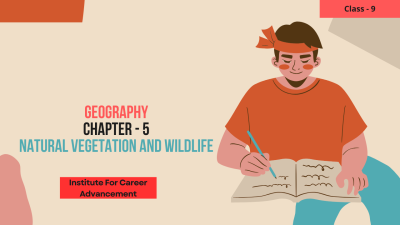Natural Vegetation and Wildlife - Class 9
Natural Vegetation and Wildlife is a topic that explores the diverse plant and animal life found in different regions of the world. It examines the factors that influence the distribution of vegetation and wildlife, such as climate, soil, and topography. Key aspects of this topic include: Types of vegetation: Forests, grasslands, deserts, tundra, and aquatic vegetation. Factors affecting vegetation: Climate, soil, topography, and human activities. Wildlife habitats: Terrestrial, aquatic, and aerial habitats. Biodiversity: The variety of plant and animal species in a particular region. Conservation efforts: Strategies to protect and conserve biodiversity. প্রাকৃতিক উদ্ভিদ ও বন্যপ্রাণী এমন একটি বিষয় যা বিশ্বের বিভিন্ন অঞ্চলে পাওয়া বিভিন্ন উদ্ভিদ ও প্রাণী জীবনের অন্বেষণ করে। এটি জলবায়ু, মাটি এবং ভূসংস্থানের মতো গাছপালা এবং বন্যপ্রাণীর বিতরণকে প্রভাবিত করে এমন কারণগুলি পরীক্ষা করে। এই বিষয়ের মূল বিষয়গুলির মধ্যে রয়েছেঃ উদ্ভিদের প্রকারঃ বন, তৃণভূমি, মরুভূমি, তুন্দ্রা এবং জলজ উদ্ভিদ। গাছপালাকে প্রভাবিত করে এমন কারণঃ জলবায়ু, মাটি, ভূসংস্থান এবং মানুষের ক্রিয়াকলাপ। বন্যপ্রাণীর আবাসস্থলঃ স্থলজ, জলজ এবং বায়বীয় আবাসস্থল। জীববৈচিত্র্যঃ একটি নির্দিষ্ট অঞ্চলে উদ্ভিদ ও প্রাণী প্রজাতির বৈচিত্র্য। সংরক্ষণ প্রচেষ্টাঃ জীববৈচিত্র্য রক্ষা ও সংরক্ষণের কৌশল।
English
Last updated
Wed, 27-Nov-2024



















